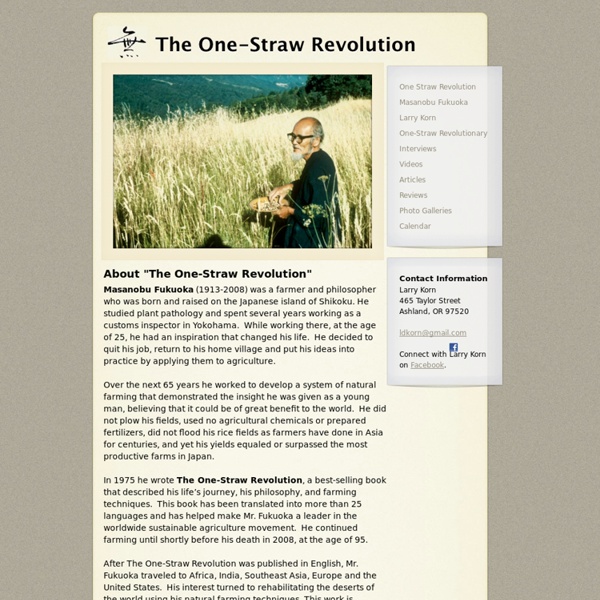Off Gridders | A Practical Guide for Permaculturists Living Free
The Jean Pain Way
In the book Another Kind of Garden, the methods of Jean Pain are revealed. He spent his entire short-lived life studying brush land and forest protection, specifically fire prevention, alongside his wife Ida. These studies led to an enormous amount of practical knowledge for composting, heating water, as well as harvesting methane, all of which are by-products of maintaining a forest or brush land with fire prevention techniques. While this knowledge is applicable in many instances, it is worth remembering that the root of all of this knowledge lies in forest preservation. "Just think that it is a question here of trying to safeguard 1 000 hectares, with success guaranteed, that 16 people will directly find a well paid job, that the equivalent of 480 000 liters of motor fuel will be produced each year, as will 6 000 tons of this precious humic improver which has great value as a fertilizer, and which could even enable reafforestation of the same number of hectares in the same year
Nature’s matrix: Linking agriculture, conservation and food sovereignty
An important book argues that conservationists who focus on creating nature preserves are undermining their own cause. To truly protect biodiversity, environmentalists must support the global struggle of peasant farmers for human rights, land, and sustainable agriculture. NATURE’S MATRIX Linking Agriculture, Conservation and Food Sovereignty by Ivette Perfecto,John Vandermeer,and Angus Wright Earthscan, 2009 reviewed by Ian Angus In any discussion of biodiversity and species extinction, someone insists that overpopulation is the problem. For a convincing antidote to such views, I highly recommend Nature’s Matrix, an important book by ecologists Ivette Perfecto, John Vandermeer and Angus Wright. The issue is not how many people there are, but what the people do: some forms of agriculture destroy life, others preserve and expand it. A doomed strategy “On the reserves purchased through donations to the Trust, which are expertly managed by its overseas partners, permanent protection is in place.
Indigenous Elders - 'Mankind has gone too far' - Earth Tribe
First Nations anti-fracking protest in New Brunswick, Canada Maybe Facebook has provided a helping hand. All around the world, indigenous groups are finding voice, through Facebook and other non-mainstream media, with a message common to all – Save Mother Earth. Brenda Norrell, in her useful news service, writes that indigenous Elders and Medicine People said there is no time left to defend the Earth. (See full story by Brenda Norrell here – Indigenous Elders: No time left to defend the Earth – ) Chief Arvol Looking Horse, Lakota, with a Council of Indigenous Elders and Medicine Peoples, issued a statement saying mankind can no longer ignore the teachings to protect the Earth. The First Nations anti-fracking protest in New Brunswick, Canada, is a prominent example of those who feel their roots in the land trying to protect it from invasive fossil fuel companies.
Coppicing - A Lost Art Revisited - Verge Permaculture
Coppicing has always been interesting to me as a wood production system (fuel, timber) because it uses trees that can be cut perpetually. In other words, the tree is cut and grows back. This is quite different from the type of forestry we practice here in Canada with spruce, fir, and pine trees. Here is a great Wikipedia definition on coppicing: In Canada we can grow a number of different trees that can be cut and grow back. Here is a great video on Coppicing from Britain. In addition to fuel and timber coppice systems can be used for basketry, propagation, mulch and fodder. In Ohaton in Camrose County, Alberta, they are using willow to clean up their waste water from a lagoon while growing a feed stock for producing heat for the municipality. Dave Jake and Mark Krawczyk are currently working on a book on Coppice Agroforestry which, if it is anything like his last book Edible Forest Gardens Vols I & II, will be amazing!
The Genius of Jean Pain
Related Content Phil's Dancing Carrots If you are challenged by growing carrots, you might consider transplanting them and growing some dan... The warm, dry, and rocky Provence region of France is better known for its resorts than for its suitability to gardening. Yet—among that area's craggy hills—a self-taught organic gardener, forester, and biotechnologist named Jean Pain is working wonders with a new technique of composting. By removing underbrush from his woodlands and pulverizing it in a shredder of his own design, M. A few months ago one of MOTHER EARTH NEWS' staffers visited Jean and Ida Pain at their home in France, and discussed the techniques which the inventive agronomist has developed to overcome the hardships of the impoverished native soil and become self-sufficient . . . while restoring the ravaged forests of their area to a lushness that the region hasn't known for centuries. As M. [3] Saturation: M. Composting Operation A Compost Water Heater Brush Gas
Cradle to Cradle: Remaking the Way We Make Things | William McDonough
One of the most influential recent books on design and environmentalism.” —Alice Rawsthorn, The New York Times [McDonough] point[s] to a path out of the seemingly un-winnable trench war between conservation and commerce.” —James Surowiecki, The New Yorker A rare example of the ‘inspirational’ book that actually is.” —Steven Poole, The Guardian [McDonough and Braungart’s] ideas are bold, imaginative, and deserving of serious attention.” —Ben Ehrenreich, Mother Jones [A] clear, accessible manifesto . . . —Publishers Weekly A readable, provocative treatise that ‘gets outside the box’ in ahuge way. —Kirkus Reviews For those of us who have a hunger to know what the next great idea will be, this highly readable book captures and challenges the imagination.” —Sarah D. With this book, McDonough and Braungart open our eyes to the way to genuine sustainability by the study of nature and mimicking her ways. —Dr.
Work That Reconnects Network — Take part in the healing of our world!



